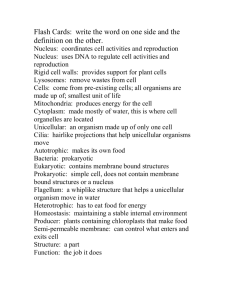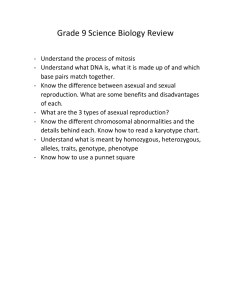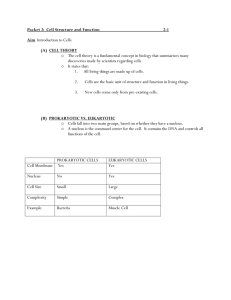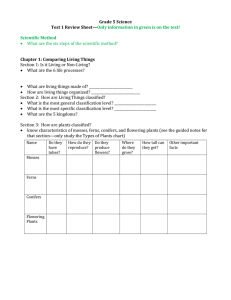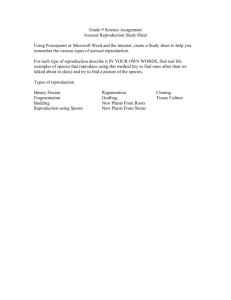The Unity & Diversity of Life An Overview
advertisement
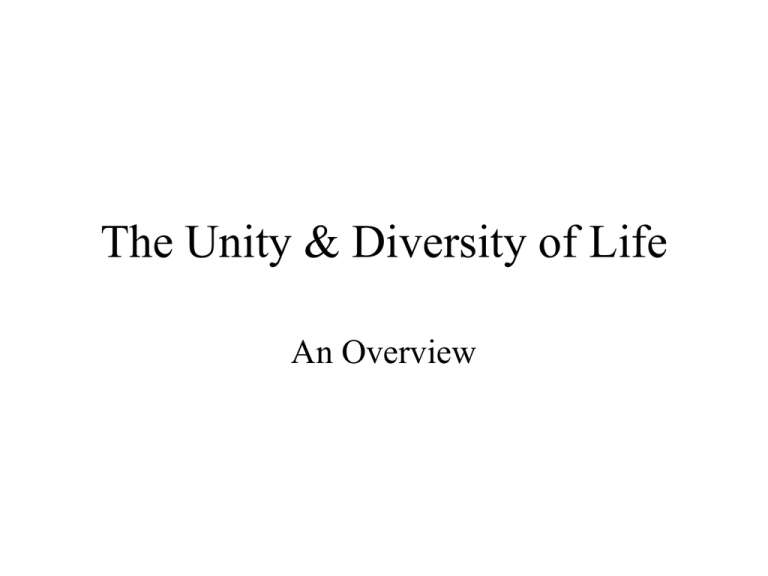
The Unity & Diversity of Life An Overview Vocabulary to know: • Prokaryotic: cell contains no nucleus, no membrane-bound organelles, but does have ribosomes and DNA • Eukaryotic: cell has a nucleus, organelles, ribosomes and DNA • Unicellular: made up of one cell • Multicellular: made up of many cells • Autotroph: an organism that makes its own food • Heterotroph: an organism that depends on others for food Kingdom: Archaea • Cell Structure: prokaryotic (no nucleus) • Unicellular • They can make their own food by a process called chemosynthesis, or they can consume food. (autotroph/heterotroph) • Reproduction: asexual by binary fission • FYI: – Typically found in extreme environments – Thought to be the most primitive organisms on Earth Yellowstone Nat’l Park Hot Springs Kingdom: Bacteria • Cell Structure: prokaryotic (no nucleus) • Unicellular • Autotrophic (chemosynthesis & photosynthesis) or heterotrophic (recall fermentation) • Reproduction: mostly asexual by binary fission, though some can reproduce sexually by conjugation. • FYI: – Not all bacteria are harmful to humans – They come in many shapes – Used for biotechnology Kingdom: Protists • Cell Structure: eukaryotic (has nucleus) • Unicellular • Autotrophic (photosynthesis) or heterotrophic • Reproduction: mostly asexual (binary fission), but some sexual (conjugation) • FYI: – Mostly found in moist environments Kingdom: Fungi • Cell Structure: eukaryotic (has nucleus)- some have more than one! • Multicellular • Heterotrophic- they’re decomposers • Reproduction: asexual or sexual • FYI: – Some fungi can be harmful (Athlete’s foot, ringworm) – Others are useful: yeast, edible mushrooms Kingdom: Plants • Cell Structure: eukaryotic (has nucleus) • Multicellular • Autotrophic (photosynthesis) • Reproduction: mostly sexual • FYI: – Carnivorous plants are NOT heterotrophs, they can also do photosynthesis. – Self-pollination is NOT asexual reproduction Kingdom: Animals • Cell Structure: eukaryotic (has nucleus) • Multicellular • Heterotrophic • Reproduction: mostly sexual • FYI: – Some animals can reproduce asexually (regeneration, budding, fragmentation)- ex.: starfish Hydra Starfish More about Plants & Animals • Plants and animals have many structural adaptations- this is the reason we see so many different kinds of them. • Recall an adaptation is any inherited trait that increases an organisms chance of survival. • What kinds of adaptations have they come up with, and what purpose do they serve? Plant Adaptations • For life on land: – Vascular tissue- tube-like cells that transport water and nutrients from roots to leaves • Called xylem (for water) and phloem (for food) – Roots- help anchor the plant to the ground and absorb water and nutrients from soil • Desert plants have shallow roots- quickly absorb rain Plant Adaptations – Stems- support plant • hold up leaves for photosynthesis • hold up flowers to pollinators • transport water and food • can protect against predators Plant Adaptations – Leaves- used for photosynthesis, control gas exchange and water loss • Rainforest floor- broad leaves • Desert- cactus have spines to prevent water loss • Cold climates- needles on evergreen trees Plant Adaptations • For Reproduction: – Attracting pollinatorsbrightly colored or fragrant flowers – Seeds- protective coat outside, nourishment inside to protect plant embryo and allow it to lie dormant for awhile. Animal Adaptations • For life on land: – Amniotic eggprovides food & protection to developing embryo (Reptiles developed it first.) Animal Adaptations • Reproductive: – Internal fertilizationsperm more likely to get to the egg, and egg is protected inside the female Animal Adaptations • Predators: – Speed- ex.: lions, cheetahs – Toxin production to stun/kill prey- ex.: jellyfish, snakes – Hunt at dark using • Echolocation- ex.: bats • Night vision/big eyesex.: owl Animal Adaptations • Prey: – Mimicry- look like something harmful – Camouflage- blend in – Warning colors & toxins • Ex. Monarch butterfly, poison dart frogs – Puff up- look bigger – Regeneration- grow back legs or tails Snowshoe Hare Camoflauge for all seasons
